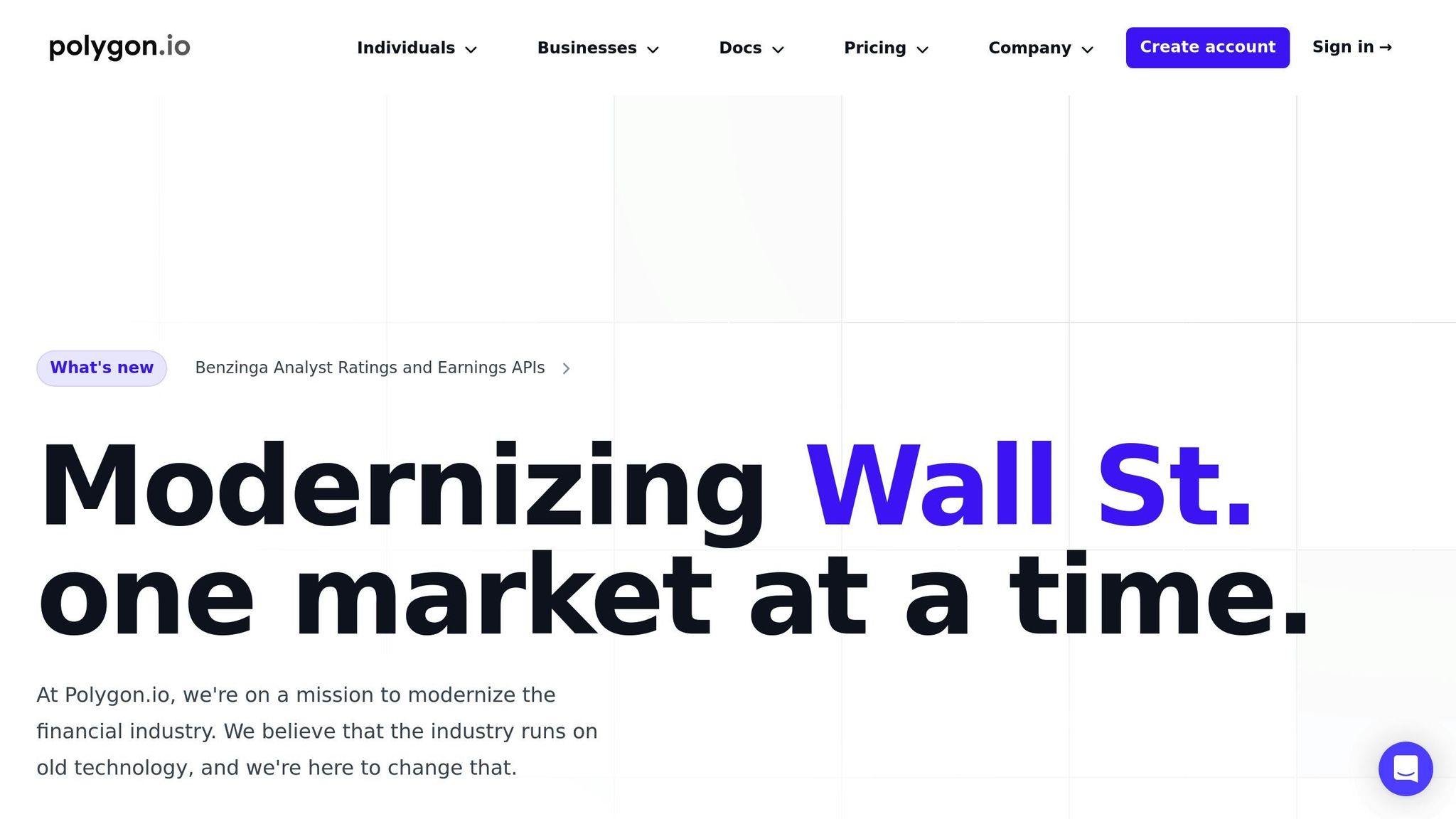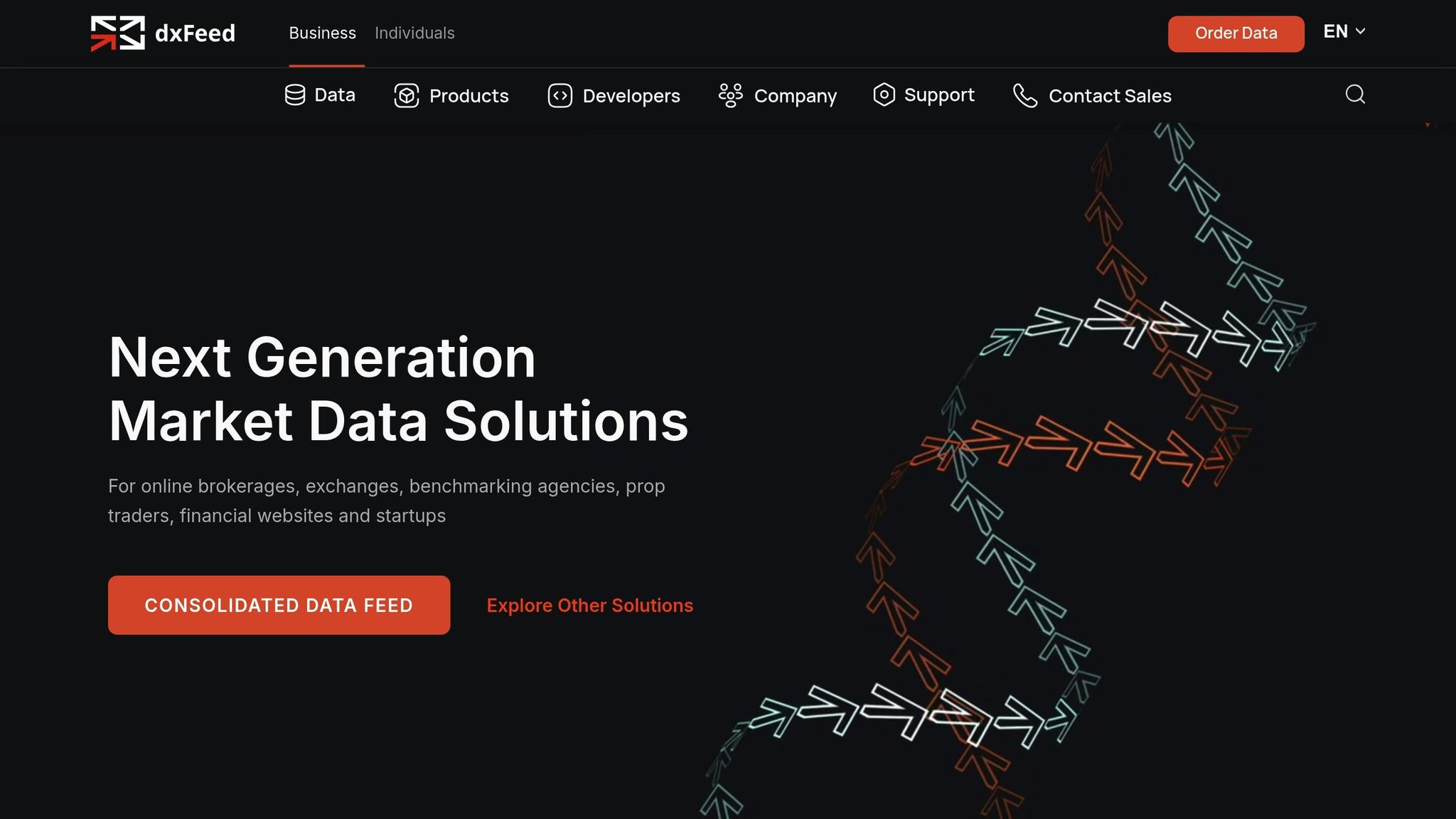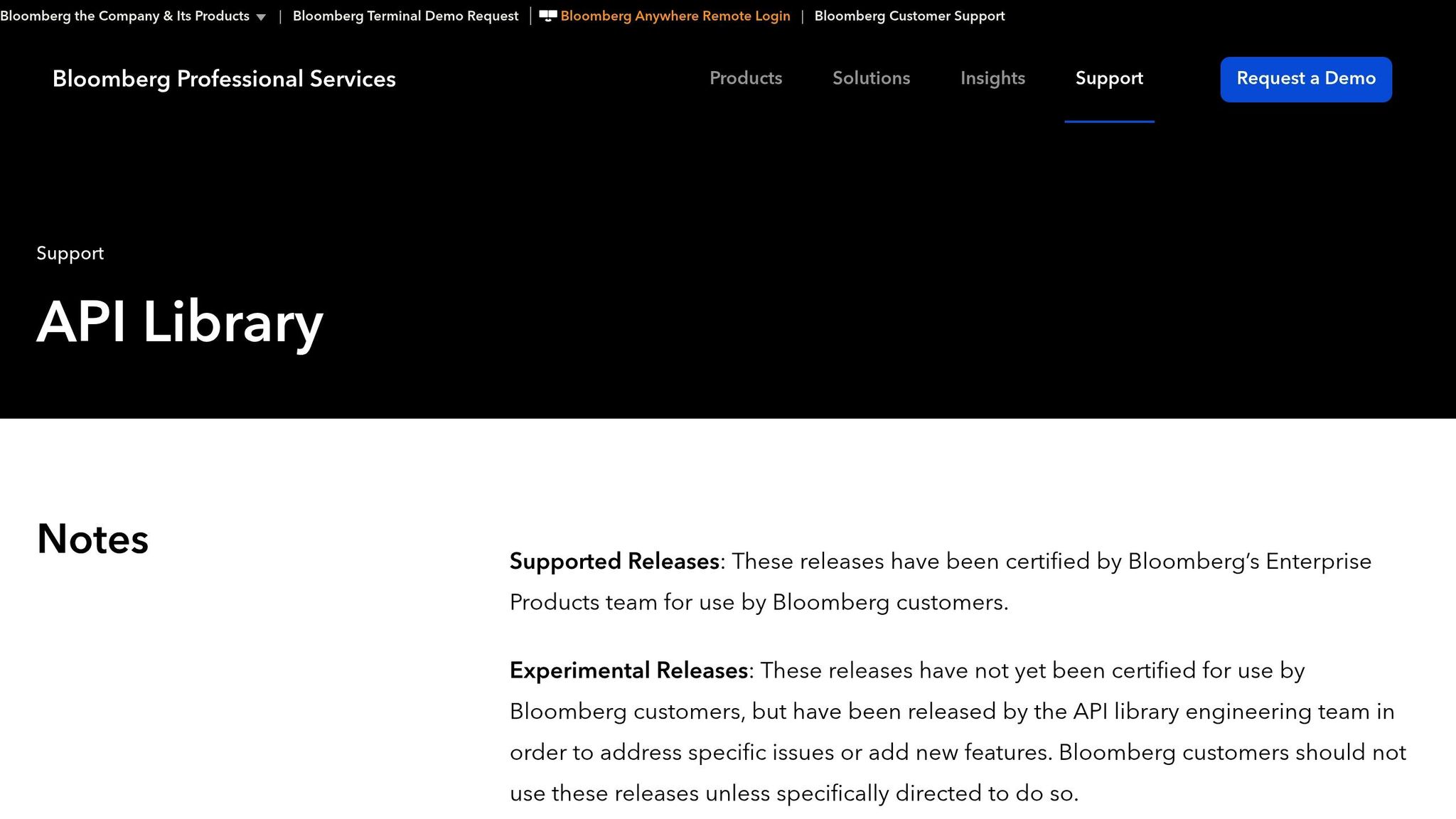High-frequency trading (HFT) depends on ultra-fast decision-making, and market data APIs are the backbone of this process. These APIs provide real-time and historical data for assets like stocks, options, currencies, and futures, enabling traders to execute strategies with precision. The key factors for HFT are low latency (under 20ms), wide data coverage, and seamless integration into trading systems.
Key Insights:
- Polygon.io: Known for its sub-20ms latency, direct exchange connections, and extensive multi-asset coverage. It supports real-time streaming and historical data access with developer-friendly integration options.
- dxFeed: Offers market data but lacks publicly available performance details, particularly for HFT use cases.
- Bloomberg API: Renowned for data breadth but provides limited transparency on latency or suitability for HFT.
Polygon.io stands out for its speed, reliability, and ease of integration, making it a strong candidate for HFT operations. However, traders should evaluate their specific needs and test APIs like dxFeed and Bloomberg for compatibility and performance.
Demo: Streaming Real-Time Stock Market Data with Polygon.io + Python

1. Polygon.io
Polygon.io serves as a high-performance market data provider tailored for trading professionals, particularly those involved in high-frequency trading (HFT). Offering real-time and historical data across multiple asset classes, it combines speed, reliability, and extensive data coverage to meet the rigorous demands of HFT operations. Let’s dive into how Polygon.io delivers on these fronts.
Latency
When it comes to HFT, speed is everything – and Polygon.io delivers with sub-20ms latency. This impressive performance is achieved through a proprietary infrastructure that the company fully owns and operates. From direct fiber cross-connects to major exchanges to API delivery, Polygon.io controls every step of the data pipeline. This end-to-end ownership eliminates the bottlenecks that often slow down third-party providers.
"We’re located in the datacenter with direct fiber cross-connects to the exchanges. We own the entire infrastructure so we can ensure quality at each step in the pipeline. Direct connectivity means faster updates, fewer points of failure, and accurate market data you can depend on for your applications." [1]
The system is also built to handle spikes in data volume during market volatility. Its redundant and horizontally scalable design ensures consistent performance, even during the most demanding trading sessions.
Data Coverage
For traders building complex strategies, access to diverse and detailed data is critical. Polygon.io supports five major asset classes: stocks, options, indices, currencies (including forex and crypto), and futures. This wide-ranging coverage allows traders to consolidate their data needs into a single provider, avoiding the hassle of juggling multiple vendor relationships.
- Futures: Covers major exchanges like CME, CBOT, NYMEX, and COMEX, with 262,000 futures tickers and historical data dating back to May 13, 2017, totaling over 72 million rows of data.
- Stocks: Includes 32,345 tickers spanning all U.S. exchanges, dark pools, and OTC markets, with records going back to September 1, 2003.
- Options: Features 1,670,030 tickers with data available from July 18, 2014, encompassing more than 722 billion rows.
This extensive dataset equips traders with the information they need to execute informed strategies across a variety of markets.
Integration Support
In fast-paced trading environments, seamless integration is key. Polygon.io offers flexible options to suit different trading systems. Developers can choose between RESTful APIs for on-demand data access or WebSocket connections for real-time streaming – an essential feature for HFT operations.
The platform’s "API first approach" ensures compatibility across programming languages, with data delivered in standardized JSON and CSV formats. For bulk data needs, Polygon.io provides flat files via an S3 interface and SQL query options for customized retrieval.
To make integration even smoother, Polygon.io offers extensive documentation, tutorials, and client libraries. These resources help development teams get up and running quickly, minimizing delays in deploying new trading strategies.
"We had no idea the landscape around market data was so complex. Polygon did the best job at simplifying the entire process." – Adam Hano, Co-Founder [1]
2. dxFeed

dxFeed often comes up in discussions about high-frequency trading (HFT), but public information about its performance is quite sparse. Details like latency, data coverage, scalability, or how well it integrates with HFT systems aren’t readily available from external sources.
If you’re curious about how dxFeed performs in HFT scenarios, the best approach is to check their official documentation or reach out to their technical support team. They can provide the most accurate and up-to-date insights. Compared to competitors who often share detailed benchmarks, dxFeed’s limited public disclosure stands out and warrants closer examination in the following section.
3. Bloomberg API

The Bloomberg API is widely recognized, but its performance in high-frequency trading (HFT) remains a mystery. Details about its capabilities in this area are not shared publicly. When evaluating its potential for HFT, two critical factors to focus on are latency and data coverage. Let’s break these down further.
Latency
Since Bloomberg doesn’t provide public data on latency, achieving the microsecond-level precision required for HFT would require conducting your own independent tests.
Data Coverage
Bloomberg is well-known for offering a vast array of data tailored for traditional trading. However, whether this data has the granularity needed for HFT is unclear. It’s essential to confirm that the data aligns with the specific demands of your HFT strategy.
Advantages and Disadvantages
This section dives into the strengths and challenges of the APIs used in high-frequency trading (HFT).
Polygon.io stands out with its ability to deliver real-time data at lightning-fast speeds – less than 20ms latency – thanks to direct fiber cross-connects to exchanges. This setup not only minimizes points of failure but also ensures highly accurate data delivery [1]. Its coverage is extensive, with access to over 32,345 stock tickers, 1,670,030 options tickers, 11,409 indices tickers, 1,750 currency tickers, and 262,000 futures tickers [1].
Polygon.io’s performance has been tried and tested by industry experts, earning credibility in the HFT space [1]. It also offers strong developer support and detailed integration resources, making it easier to incorporate into trading workflows. Built on a cloud-native architecture with horizontal scalability, it’s designed to handle the demanding requirements of various HFT strategies.
On the other hand, specific performance data and integration insights for dxFeed and Bloomberg API in the context of HFT are harder to find. Traders considering these platforms should reach out directly to the providers for detailed information and conduct their own testing to ensure compatibility with their infrastructure.
One key consideration for HFT is latency. While Polygon.io’s sub-20ms latency is impressive, traders pursuing strategies that demand microsecond-level precision may need to explore specialized solutions, such as co-location services or dedicated market data feeds.
Conclusion
To wrap up the analysis, Polygon.io stands out as a top-tier market data API for high-frequency trading (HFT) operations, offering the speed and precision that this field demands. With latency consistently under 20 milliseconds [1], it delivers the rapid data delivery essential for HFT success.
Beyond speed, Polygon.io provides extensive multi-asset coverage and a cloud-native infrastructure designed for redundancy and horizontal scalability. This means traders can expand their operations without worrying about performance bottlenecks – a crucial factor in fast-paced trading environments.
For firms seeking seamless integration, Polygon.io’s developer-friendly approach simplifies the process. As Adam Hano, Co-Founder, shared:
"We had no idea the landscape around market data was so complex. Polygon did the best job at simplifying the entire process."
This insight underscores the platform’s focus on streamlining implementation for its users.
Another standout feature is its transparent pricing structure, which allows HFT firms to plan and manage costs with confidence – an often overlooked but critical aspect of trading operations.
FAQs
What should I look for in a market data API for high-frequency trading?
When selecting a market data API for high-frequency trading (HFT), prioritize low latency and high performance. These are crucial for processing massive amounts of real-time data swiftly and dependably – key requirements for executing HFT strategies effectively.
It’s also important to evaluate the API’s data accuracy, stability, and ability to scale during volatile market conditions. Opt for providers that offer strong customer support and well-structured documentation to make integration with your automated trading systems more seamless.
How does Polygon.io deliver reliable, low-latency market data for high-frequency trading (HFT)?
Polygon.io achieves low latency and high reliability by strategically colocating its infrastructure in data centers equipped with direct fiber cross-connects to major exchanges. This configuration ensures real-time data delivery with latency consistently below 20 milliseconds.
The platform is also built for resilience and scalability. By incorporating full redundancy and horizontal scaling, it can manage large data volumes seamlessly. This design guarantees uninterrupted performance, which is essential for high-frequency trading (HFT) strategies.
Why is it important to assess how a market data API integrates with high-frequency trading systems?
Assessing how well a market data API integrates with your system is key to maintaining efficient performance in high-frequency trading (HFT). A properly integrated API ensures smooth data flow, minimizes delays, and helps execute trades with the least possible latency.
When analyzing an API, focus on aspects like the supported data formats (such as JSON or CSV), the availability of client libraries for your chosen programming languages, and the clarity of its documentation. These factors play a big role in determining how quickly and effectively the API can be implemented into your trading setup, ensuring the speed and reliability that HFT demands.








